¶ Toolhead Linear Guideway Assembly
This document provides guidelines and precautions for replacing the H2S toolhead linear guideway assembly, excluding the disassembly and assembly of the toolhead itself.
¶ When to Replace
- The toolhead linear guideway assembly is damaged or fails to function as expected
¶ Required Tools and Materials
- New Tool Head with X-Axis Assembly
- H1.5 and H2.0 hex key wrenches, short hex key wrench
- L-shaped hex key wrench
- Tweezers
¶ Safety Warning
It's crucial to power off the printer before conducting any maintenance work, including work on the printer's electronics and tool head wires. Performing tasks with the printer on can result in a short circuit, leading to electronic damage and safety hazards.
During maintenance or troubleshooting, you may need to disassemble parts, including the hotend. This exposes wires and electrical components that could short circuit if they contact each other, other metal, or electronic components while the printer is still on. This can result in damage to the printer's electronics and additional issues.
Therefore, it's crucial to turn off the printer and disconnect it from the power source before conducting any maintenance. This prevents short circuits or damage to the printer's electronics, ensuring safe and effective maintenance. For any concerns or questions about following this guide, open a new ticket in our Support Page and we will do our best to respond promptly and provide the assistance you need.
¶ Disassembly Steps
¶ Step 1: Lower the Heatbed
Lower the heatbed via the screen, ensure the hotend is at room temperature, then turn off the printer.
 |
 |

¶ Step 2: Remove the PTFE Tube
Press the PTFE Tube Coupler on the top of the toolhead to disconnect the PTFE tube above the toolhead. Push out the PTFE Tube Coupler of the filament buffer and press to unlock it.
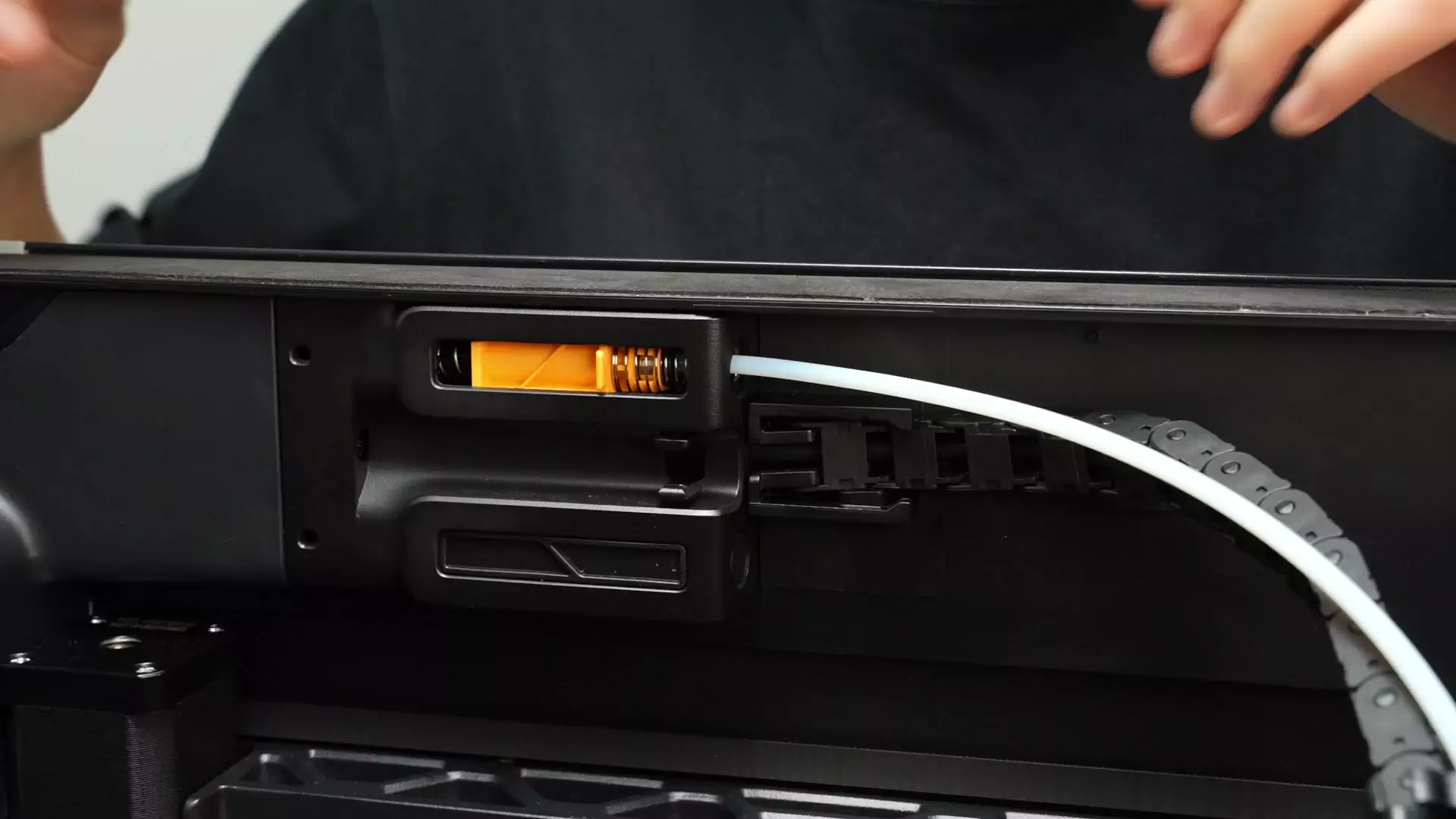 |
 |
Pull the PTFE tube out of the cable chain.

Then unlock the PTFE Tube Coupler at the filament inlet on the back of the printer and remove the PTFE tube.

¶ Step 3: Remove the Hotend
Refer to this tutorial to remove the hotend (Click here to jump)
¶ Step 4: Remove the AP Cable Organizer Cover
Use an H2.0 hex key wrench to remove 1 fixing screw (BT2.6x8), then take off the AP Board cover from the side near the front door.
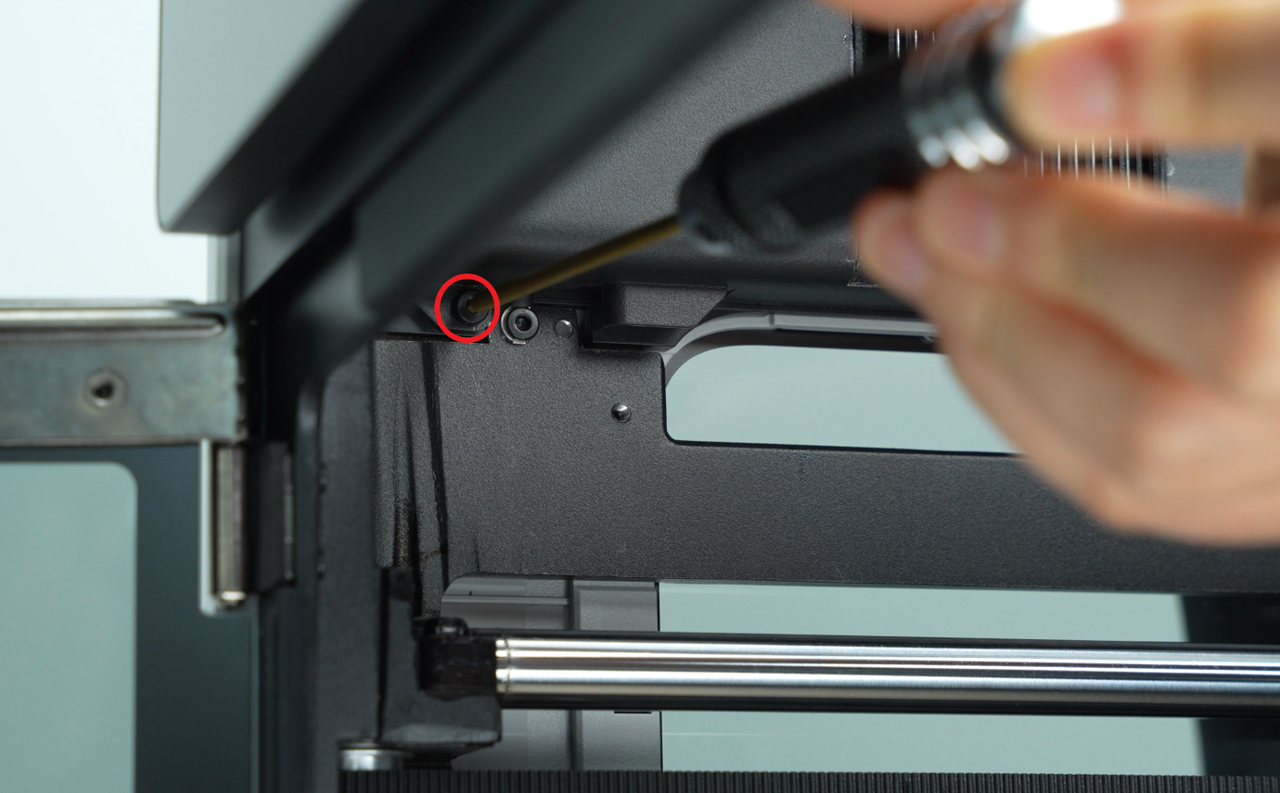 |
 |
¶ Step 5: Remove the Filament Buffer and Disconnect the USB-C Cable
Unscrew the screw in the USB-C cable organizer clip.

Pull the cable out of the clip and disconnect the USB-C cable;

Use an H2.0 hex key wrench to remove the four fixing screws and loosen the filament buffer.
 |
 |
Pull the USB-C cable out of the clip.

¶ Step 6: Remove the Cable Chain
Remove this section of the cable chain from the slot. Note: First pull the cable chain slightly downward to disengage the upper right corner of the cable chain from the slot, then pull out the entire cable chain with force.
(Operation example shown on H2D; the operation method for H2S is identical)
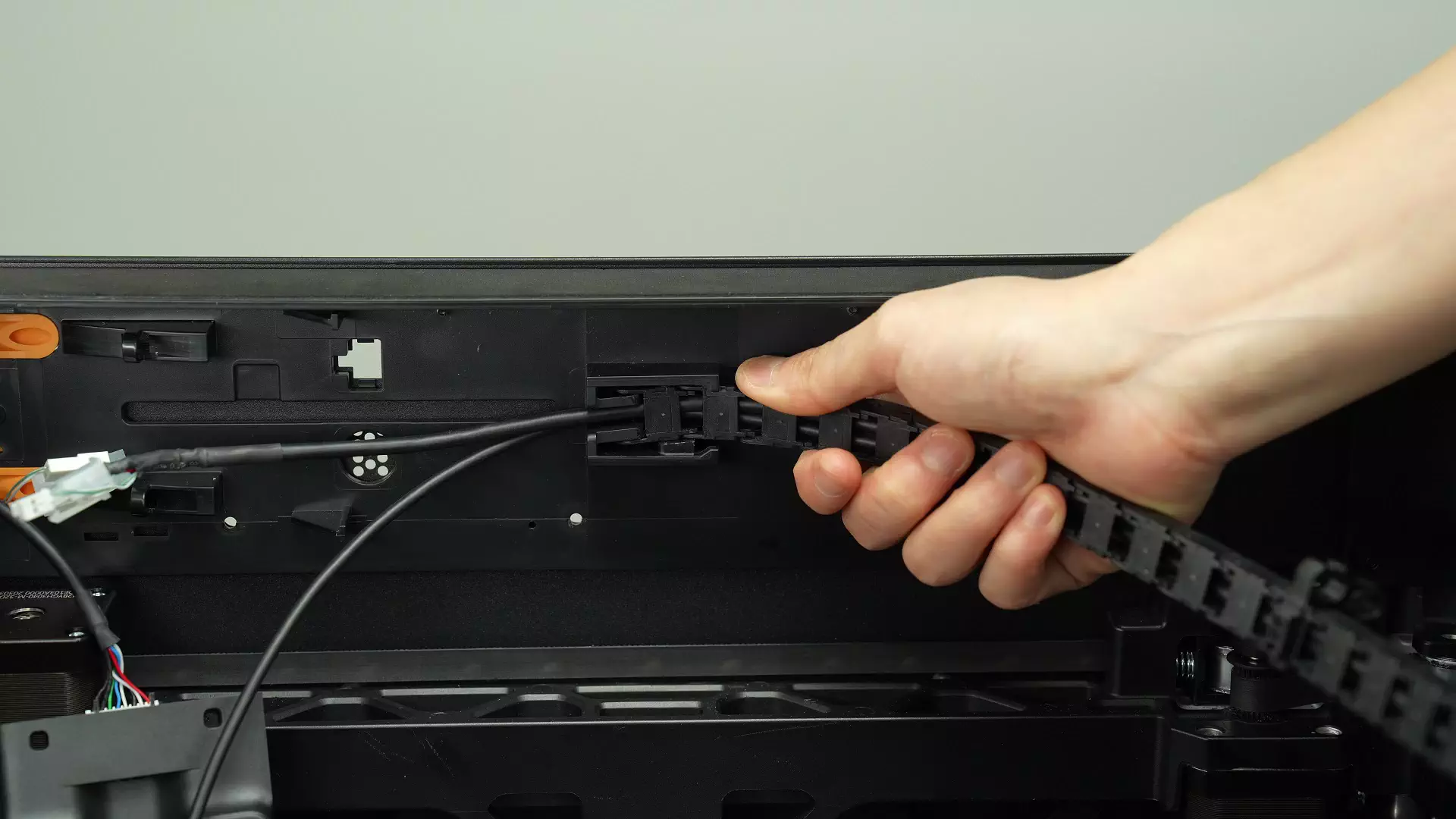 |
 |

¶ Step 7: Remove the Belt
Unscrew the 2 screws on the belt holder and remove the belt holder.
 |
 |
Remove the belt holder on the other side using the same method.
 |
 |
¶ Step 8: Attach Non-marking Tape to Both Sides of the Linear Guideway to Prevent Slider Balls from Falling Out
Attach non-marking tape to both sides of the toolhead. If no non-marking tape is available, attach paper to the linear guideway and secure it with transparent tape. The purpose of this step is to restrict the movement of the toolhead and prevent it from sliding off the linear guideway when the guideway is removed.

¶ Step 9: Remove the Toolhead with X-axis Assembly
Use tweezers to assist in removing the LED light covers on the left and right sides.
 |
 |
There is a reserved hole in the middle of the printer frame. Insert an L-shaped hex key wrench through this hole to easily remove the linear guideway screw on the top of the carriage.
Remove the linear guideway screw on the other carriage using the same method.
 |
 |

Then remove the 4 screws on the side of the linear guideway and the 2 screws at the bottom of the carriage.
 |
 |
 |
 |
After removing all screws, the linear guideway can be removed. When removing the linear guideway, first disengage the right-side guideway from the carriage, then disengage the left-side guideway from the carriage, and then take out the guideway at an angle.

¶ Installation Steps
¶ Step 1: Install the Linear Guideway Assembly
When installing the new linear guideway assembly, first insert the right-side guideway into the carriage, then insert the left-side guideway into the carriage. Push the guideway forward until it can no longer move—this step uses the front door pillar for positioning to ensure the guideway is parallel.
 |
 |
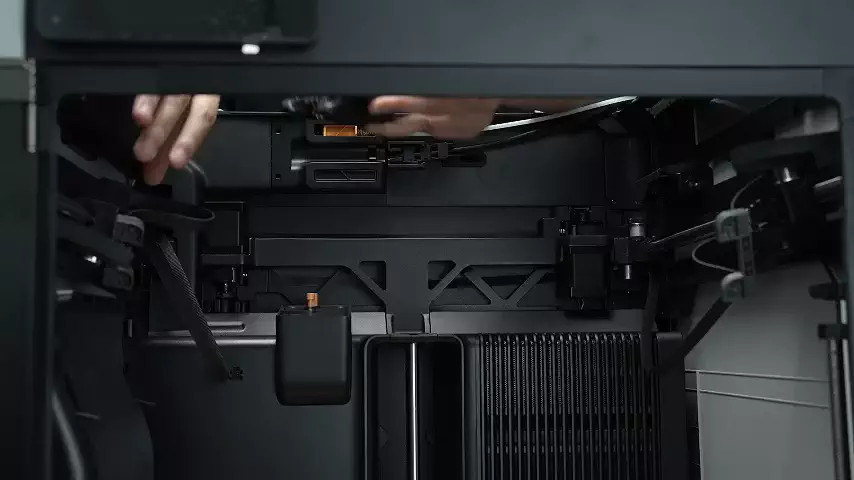
To ensure the linear guideway is parallel, the guideway must be pushed to the foremost position before installing the guideway screws. Unlike the disassembly step, the guideway cannot be pushed to the middle position to install screws with an L-shaped hex key wrench. Therefore, it is recommended to use a short hex key wrench to directly install the 2 screws on the carriage, the 4 screws on the side of the guideway, and the 2 screws at the bottom of the carriage.
Note: The screws on the top and bottom of the carriage are fine-thread screws, while the screws on the side of the linear guideway are coarse-thread screws—do not mix them up.
 |
 |
 |
 |
 |
 |
Align the clips and reinstall the left and right LED light covers.

¶ Step 2: Remove the Cable Ties
After installing the linear guideway assembly, use needle-nose pliers to cut the cable ties on both sides of the toolhead.

¶ Step 3: Install the Belt
Reinstall the belt holder into the slot of the toolhead, then screw in the 3 belt holder screws.
 |
 |

Then push the toolhead to the other side and install the other belt holder. Since the first belt holder is already installed, the resulting tension may make it difficult to install the second one. First, pre-tighten the middle screw (do not fully tighten it). After fully tightening the upper and lower screws, re-tighten the middle screw.
 |
 |
¶ Step 4: Install the Cable Chain
Connect the cable chain to the printer frame (Operation example shown on H2D; the operation method for H2S is identical)
After fitting the convex points of the cable chain clips into place, push forward to ensure proper installation.
 |
 |
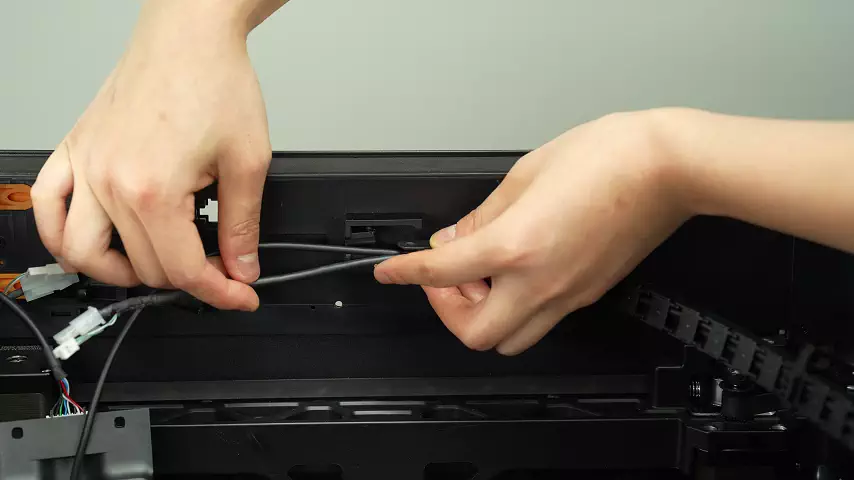
¶ Step 5: Install the Filament Buffer and Connect the USB-C Cable
Clip the USB-C cable into the groove in the frame, align with the holes, and reinstall the filament buffer.
 |
 |
After aligning the filament buffer with the screw holes, use an H2.0 hex key wrench to tighten the four fixing screws (BT3×8). Finally, reconnect the two PTFE tubes to the filament buffer.

When connecting the new USB-C cable, note that the plug surface has anti-loosening tape—you will need to apply some force to insert it until it can no longer be pushed; this indicates proper insertion.
Note: The end marked "A" connects to the AP Board, and the "A" mark should face outward!
 |
 |
Then clip the cable into the cable clips one by one and re-tighten the clip fixing screw.
 |
 |
¶ Step 6: Install the AP Cable Organizer Cover
First, fasten the AP Board cover back from the side near the printer’s rear panel. Press both positions indicated by the arrows into place: the right side should be flush with the filament buffer, and the bottom should be flush with the cable protection cover. Then use an H2.0 hex key wrench to tighten 1 fixing screw (BT2.6x8).

Note: Before installing the AP Board cover, check whether the cables block the PTFE tube to avoid affecting the subsequent installation of the PTFE tube.
 |
 |
¶ Step 7: Install the PTFE Tube
Thread the PTFE tube through and connect the PTFE Tube Coupler.
 |
 |

¶ Step 8: Install the Hotend
Refer to this tutorial to install the hotend (Click here to jump)
¶ How to Verify Completion/Success
Restart the printer and perform calibration to check for error warnings. If the printer prompts that the belt needs tensioning, tension the belt.
¶ End Notes
We hope the detailed guide provided has been helpful and informative.
If this guide does not solve your problem, please submit a technical ticket, we will answer your questions and provide assistance.
If you have any suggestions or feedback on this Wiki, please leave a message in the comment area. Thank you for your support and attention!